Condensed Matter and Cold Atoms
Marcin Raczkowski, Stephen Inglis, Zi Cai and Lode Pollet
Open Quantum Systems
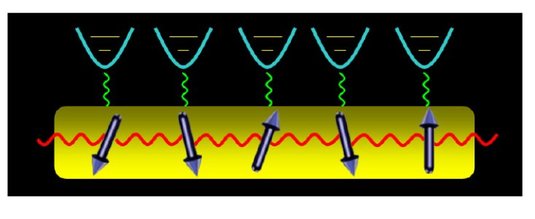
Understanding quantum systems embedded into an environment is of particular theoretical and practical importance. The situation becomes particularly interesting and complex when the system itself is already an interacting many-body system. We have developed a numerical method to deal with open quantum many-body systems based on QMC simulations with the worm algorithm, where the density operator of the system couples to the creation and annihilation operators of the bath, and found that dissipation can qualitatively change the properties of the quantum many-body states. Our numerical method can be applied to various fields ranging from dissipative cold atom systems to quantum information systems based on solid state devices.
This project is in collaboration with the group of Ulrich Schollwöck, LMU.
Entanglement
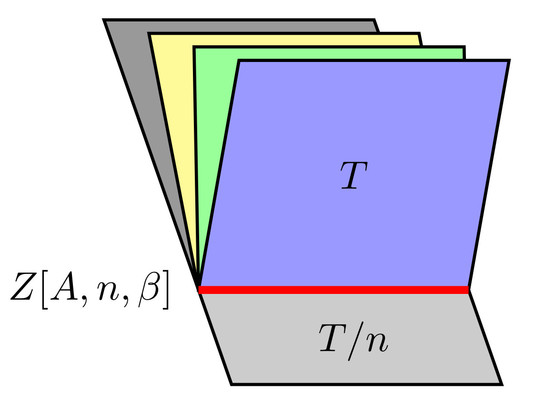 With the recent ability to calculate information based quantities in scalable numerics, it is a natural question to understand how these measures can be used alongside more traditional observables. Specifically, the Rényi entanglement entropies and related quantities can be used to classify or identify phases of matter without knowledge of the order parameter. Numerically there has been much success in one-dimensional systems, but efficiently using this method in more than one dimensions is still a current field of research.
With the recent ability to calculate information based quantities in scalable numerics, it is a natural question to understand how these measures can be used alongside more traditional observables. Specifically, the Rényi entanglement entropies and related quantities can be used to classify or identify phases of matter without knowledge of the order parameter. Numerically there has been much success in one-dimensional systems, but efficiently using this method in more than one dimensions is still a current field of research.
To this end, our research is focused on the development and expansion of methods for measuring information quantities in classical and quantum Monte Carlo. With advances in efficiency, it is possible to closely examine the shape dependence of higher-dimensional models, and distinguish between subtly different theoretical proposals. Fast, high precision calculations of this sort allow for theoretical progress and iteration in a very rapid manner.
1D/2D Crossover
A renewed interest in quasi-one-dimensional (1D) quantum many-body physics is stimulated by recent progress in trapping ultracold fermionic atoms in an optical lattice. Recently, we have investigated a dynamically generated spinon confinement in a system of weakly-coupled Hubbard chains. In the effective zero-temperature limit, the interchain exchange leads to a symmetry-broken phase with long-range antiferromagnetic correlations and confines the spinons in order to form magnons, as can be seen in the dynamical spin structure factor S(q,w).
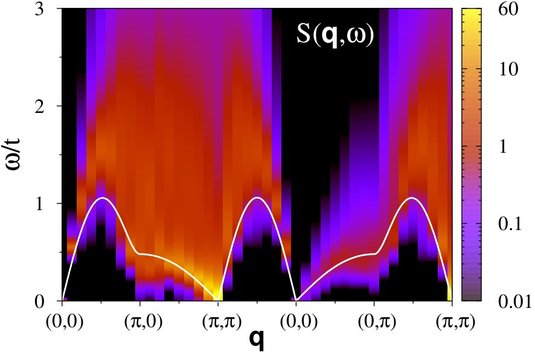
While the low-energy momentum dependence of the magnons is well described by linear spin-wave theory, the two-spinon continuum is recovered at higher frequencies. The currently undertaken research is aimed at exploring the evolution of charge dynamics in a finite-temperature crossover from the 1D Mott phase to a higher-dimensional correlated metal by looking at the frequency-dependent transverse and longitudinal optical conductivity. Our studies are based on large-scale determinant quantum Monte Carlo simulations in combination with the stochastic analytical continuation method.
This project is in collaboration with F. Assaad, University of Würzburg.
Helium
A supersolid phase is an elusive phase which has simultaneous crystalline and superfluid order. Observations of a non-classical rotational moment of inertia in solid He-4 by E. Kim and M. Chan in 2004 revived interest in this field.
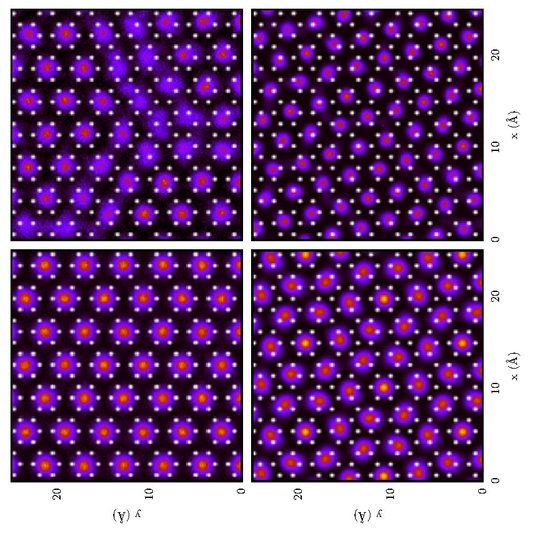 While it has meanwhile become likely that the bulk solid remains an insulator, we could nevertheless show over the past 8 years that the bulk system acts as a matrix for such defects as grain boundaries and dislocations along which superflow can occur in certain cases. Recently, we revisited He-4 inside porous media such as Vycor where we identified a topological defect (a nematic disclination with Frank index n=1, known from liquid crystals) as the key towards the understanding of the low energy physics. We also computed the phase diagram of He-4 adsorbed on graphite, graphene and currently carbon nanotubes. The picture shows the adsorption of He-4 atoms on a graphene substrate for increasing coverage (J. Happacher).
While it has meanwhile become likely that the bulk solid remains an insulator, we could nevertheless show over the past 8 years that the bulk system acts as a matrix for such defects as grain boundaries and dislocations along which superflow can occur in certain cases. Recently, we revisited He-4 inside porous media such as Vycor where we identified a topological defect (a nematic disclination with Frank index n=1, known from liquid crystals) as the key towards the understanding of the low energy physics. We also computed the phase diagram of He-4 adsorbed on graphite, graphene and currently carbon nanotubes. The picture shows the adsorption of He-4 atoms on a graphene substrate for increasing coverage (J. Happacher).
The current projects are in collaboration with Massimo Boninsegni (University of Alberta) and Anatoly Kuklov (College of Staten Island, City University of New York).
Cold Atoms
Cold atomic systems are, thanks to their cleanliness, tunability and the control experimentalists have over them, well suited to implement the prototypical models of condensed matter physics. By doing an experiment one could learn the physics of unsolvable models such as the Hubbard model. This is equivalent to quantum simulation or building a quantum analog computer. However, before such devices can be trusted they need to be benchmarked against known models. We have been deeply involved in this benchmarking phase by performing large-scale Monte Carlo simulations with realistic parameters for such models as the Bose-Hubbard model, the Hubbard model and Bose-Fermi mixtures. We also investigated polar molecules on a triangular lattice, the issue of Stoner magnetism on the repulsive branch and many other interesting systems.
Recently, in collaboration with Nikolay Prokof'ev and coworkers from the University of Massachusetts, Amherst, we extended this paradigm of quantum simulation to dynamic correlation functions. We could show the existence of a Higgs (or amplitude) mode for U(1) critical models in (2+1)d. We also computed the optical conductivity and explored in this context the validity of the AdS/CFT correspondence.
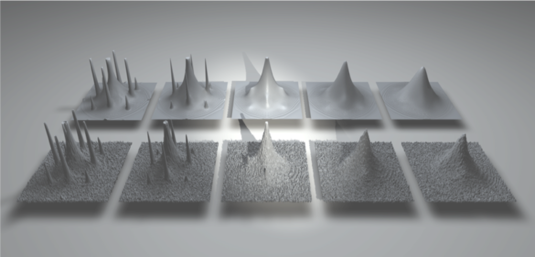
The picture shows time-of-flight images at different temperatures of a Bose-Hubbard system. Top row: simulations, bottom row: experiments performed in the group of Immanuel Bloch by Stefan Trotzky et al. (image courtesy of Stefan Trotzky and Immanuel Bloch).
Disordered Bosonic Systems
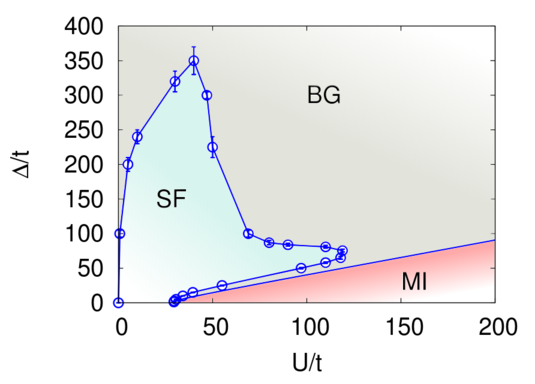 When disorder is added to a bosonic system on the lattice the physics is surprisingly rich. Apart from the superfluid phase and the Mott insulator a novel third phase is possible in the ground state. It’s a compressible, gapless but insulating phase called the Bose glass. We could show that a direct transition between the superfluid and the Mott insulator is impossible and that the Bose glass phase must intervene instead. We computed the phase diagram in three dimensions and also in two dimensions the system is rather well understood now. However, in one dimension the situation remains controversial. We could show that a strong-disorder scenario leading to a Kosterlitz-Thouless transition with a non-universal value of the Luttinger parameter at the transition exists and were able to write down semi-RG calculations indicating the asymptotical exactness of the theory. The picture shows the phase diagram of the three-dimensional Bose-Hubbard model with chemical potential disorder.
When disorder is added to a bosonic system on the lattice the physics is surprisingly rich. Apart from the superfluid phase and the Mott insulator a novel third phase is possible in the ground state. It’s a compressible, gapless but insulating phase called the Bose glass. We could show that a direct transition between the superfluid and the Mott insulator is impossible and that the Bose glass phase must intervene instead. We computed the phase diagram in three dimensions and also in two dimensions the system is rather well understood now. However, in one dimension the situation remains controversial. We could show that a strong-disorder scenario leading to a Kosterlitz-Thouless transition with a non-universal value of the Luttinger parameter at the transition exists and were able to write down semi-RG calculations indicating the asymptotical exactness of the theory. The picture shows the phase diagram of the three-dimensional Bose-Hubbard model with chemical potential disorder.
The current projects are in collaboration with Boris Svistunov and Nikolay Prokof’ev from the University of Massachusetts, Amherst.

